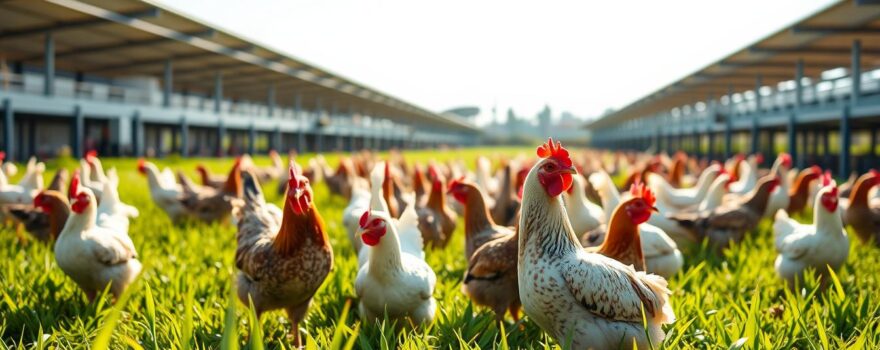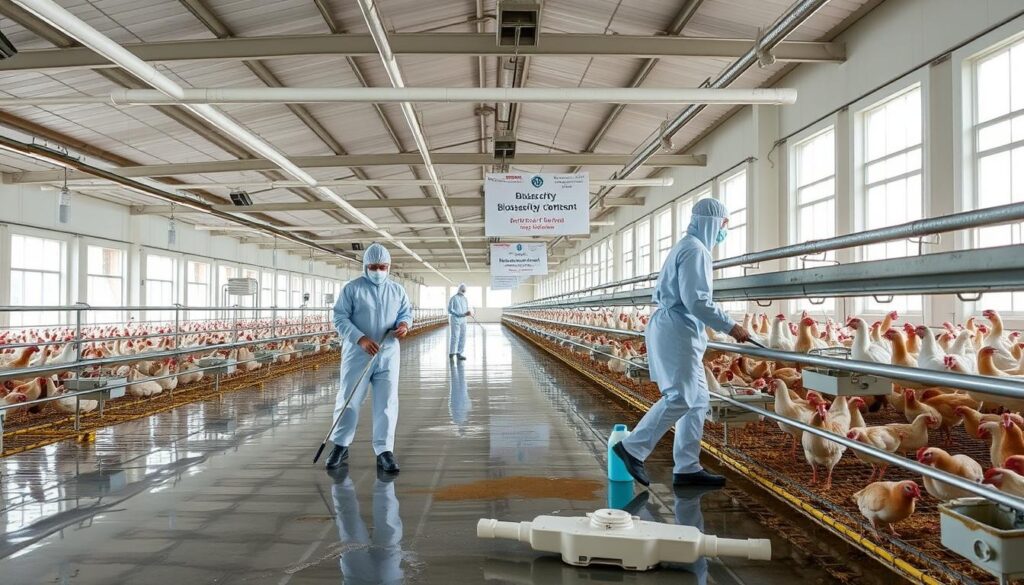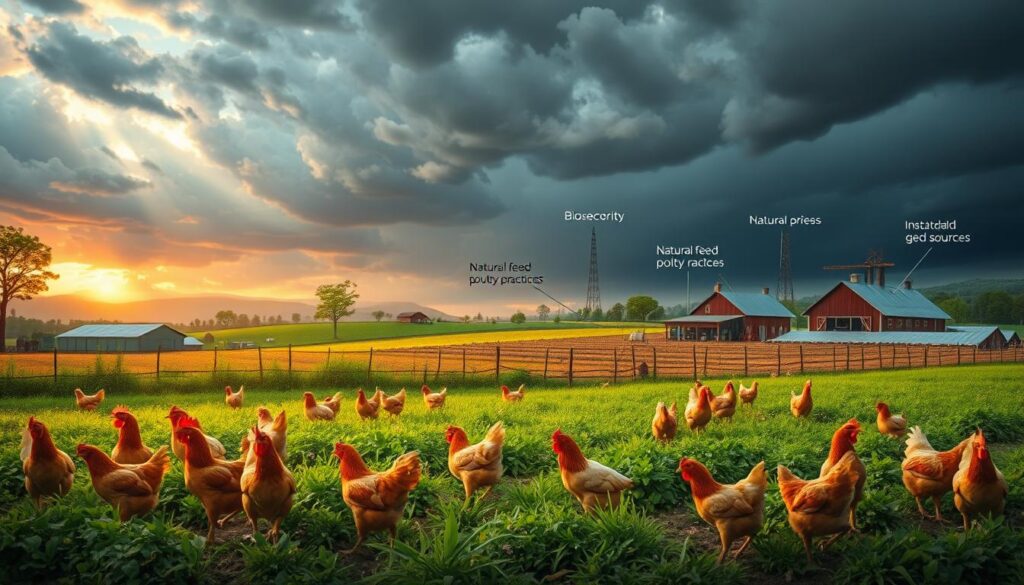
The poultry sector is key in the global agricultural world. Broiler (chicken) farming is very intensive. It offers a cheap, nutritious protein source. But, the use of antibiotics in broiler farming is a big worry.
It’s because of antibiotic resistance, which threatens treatments in both animals and humans. Cutting down on antibiotics in broiler farming is vital. It helps fight antibiotic resistance and keeps food safe and animals healthy. This article will look at ways to lower antibiotic use in broiler chicken farming.
Key Takeaways
- Biosecurity is essential for antibiotic reduction in broiler chicken farming to prevent the introduction and spread of diseases.
- Consistently high biosecurity standards can substantially reduce the risk of antimicrobial resistance by preventing the introduction of resistant genes.
- Implementing the “Two-zone Danish Entry Protocol” helps maintain a clean environment by segregating dirty and clean areas.
- Effective cleaning and disinfection of broiler houses are crucial in eliminating pathogens and reducing antimicrobial resistance.
- Proper ventilation in poultry houses is essential to prevent respiratory diseases and reduce the need for antibiotic treatments.
Introduction to Antibiotic Use in Broiler Chicken Farming
Poultry production, especially broiler chicken farming, is key in providing affordable protein worldwide. The use of antibiotics in broiler chicken farming is a big worry. It might help bacteria become resistant to antibiotics. This is bad for animals and humans, as these resistant bacteria can spread easily.
The Role of Poultry Production in Agriculture
Broiler chicken farming is very intensive. It’s a cheap way to get poultry meat. It’s crucial for meeting the world’s growing demand for food animal products and is a big part of agricultural practices.
Antibiotic Usage in Poultry Production
Antibiotics are used a lot in broiler chicken farming. They are given through water or feed to treat diseases, prevent them, and help chickens grow faster. In the U.S., tetracyclines are used in over two-thirds of animals. In the European Union, they make up only 37% of animal antibiotics.
Concerns over Antibiotic Resistance
The use of antibiotics in livestock is a big worry worldwide. It’s because of the rise of antibiotic-resistant bacteria. These bacteria can get to humans in many ways, like touching animals or eating food animal products. This makes antibiotics less effective for both animals and humans. So, we need to find ways to use fewer antibiotics in broiler farming.
| Metric | United States | European Union | Canada | Tanzania |
|---|---|---|---|---|
| Tetracycline Usage | Over 67% | 37% | N/A | N/A |
| Total Antimicrobial Sales | N/A | 8,361 tons (2015) | N/A | N/A |
| Antimicrobial Use for Prevention | N/A | N/A | 81% (2014) | N/A |
| Chicken Contamination Rates | N/A | N/A |
|
|
This overview shows how big the problem of antibiotic usage in broiler chicken farming is worldwide. It shows we need good plans to fight antibiotic resistance in agriculture.
Farm Biosecurity Measures
Biosecurity is key to stopping diseases and cutting down on antibiotics in chicken farms. It’s vital for keeping farms clean and safe from diseases. This helps lower the need for antibiotics, which is good for fighting antibiotic resistance.
Importance of Biosecurity in Antibiotic Reduction
Research shows that good biosecurity means less antibiotics. Farms with strong biosecurity plans see better animal health. This means they use fewer antibiotics and face less risk of antibiotic resistance.
Separation of High and Low-Risk Areas
Keeping high-risk and low-risk areas separate is crucial. This is done by setting up a “line of separation” around the farm. It stops diseases from spreading by controlling who and what enters each area.
Dedicated Equipment and Materials
Using special equipment and supplies for each house is important. This includes unique footwear and tools for each area. It helps avoid spreading diseases and keeps the flock healthy.
Keeping up with biosecurity plans is vital. Training workers helps make sure everyone follows the rules. This makes the farm safer and reduces antibiotic use.
“Biosecurity is the first and most effective line of defense against infectious diseases in livestock production. Implementing robust biosecurity measures can significantly reduce the need for antibiotics, ultimately enhancing the sustainability of antibiotic-free poultry farming.”
Broiler House Management
Effective poultry house cleaning and disinfection are key to stopping pathogens. This is vital in cutting down on antibiotic use. The all-out/all-in system, which removes organic material and litter between flocks, works well.
Cleaning with detergents and hot water, followed by disinfection, lowers pathogen and microbial contamination levels. It’s important to check the efficacy of cleaning and disinfection with microbiological tests. This ensures pathogens are kept at a safe level.
Waterline Cleaning and Biofilm Management
Also, keeping the waterlines clean and disinfected is key to managing biofilm buildup. This ensures birds have clean water and helps prevent disease spread. Proper waterline maintenance is crucial for reducing pathogen levels in the broiler house.
“Over 50% of broiler chickens produced in the United States are raised without antibiotics (RWA).”
Monitoring Cleaning and Disinfection Efficacy
It’s important to regularly monitor cleaning and disinfection effectiveness through microbiological testing. This ensures pathogen levels are reduced as needed. The data helps improve cleaning and disinfection methods for the broiler house.

By using thorough poultry house cleaning and disinfection procedures, and effective waterline maintenance and biofilm management, poultry producers can significantly reduce pathogen levels. This reduces the need for antibiotics in broiler chicken farming.
Ventilation for Respiratory Disease Prevention
Proper poultry house ventilation is key for keeping broiler chickens healthy and productive. It ensures good airflow, temperature, and humidity. This helps prevent respiratory diseases that might need antibiotic treatment.
In dusty places, a cubic meter of air can hold over 10 million germs. Poultry have sensitive air sacs that can easily get infected. Even a small amount of ammonia can harm their breathing system.
A good ventilation system can clear up to 80% of germs in 1-3 hours. But bad ventilation can cause breathing problems. This can lead to more antibiotics and lower productivity.
Optimizing Ventilation for Respiratory Health
- Keep an eye on and adjust ventilation settings like temperature, humidity, and air speed.
- Make sure air flows evenly to avoid stress from hot or cold spots.
- Clean and disinfect the ventilation system often to remove dust and germs.
- Check and fix the ventilation equipment regularly to keep it working well.
By focusing on poultry house ventilation and following best practices, producers can make a healthier space. This helps the birds fight off diseases better and cuts down on antibiotic use. It’s a step towards respiratory disease prevention in antibiotic-free broiler production.
How to Reduce Antibiotic Use in Broiler Chicken Farming
It’s important to cut down on antibiotics in broiler chicken farming. This is because of the growing problem of antimicrobial resistance. We need to use a mix of Antibiotic Alternatives in Poultry, Nutritional Strategies, and Probiotics and Prebiotics to do this.
Antibiotic Alternatives in Poultry
Farmers can look into using antibiotic alternatives like phytogenics, organic acids, and essential oils. These natural items help the birds’ immune system and fight off infections. This might mean using fewer antibiotics.
Nutritional Strategies
Using Nutritional Approaches can also help lower antibiotic use. Whole grains, enzymes, and special feed additives can boost gut health and make feed more efficient. This means less need for antibiotics.
Probiotics and Prebiotics
Adding Probiotics and Prebiotics to the birds’ food can change their gut microbiome. This helps their natural defenses against diseases. It can also cut down on the need for antibiotics, helping with Sustainable Broiler Production.
“The key to reducing antibiotic use in broiler farming lies in a comprehensive approach that leverages natural alternatives, optimized nutrition, and the power of the gut microbiome.”
By using these methods, broiler farmers can lessen their antibiotic use. This helps fight antimicrobial resistance and supports sustainable poultry farming.
Responsible Antibiotic Stewardship
The industry is working hard to cut down on antibiotic use in chicken farming. It’s key to use antibiotics wisely and keep an eye on Antibiotic Resistance. Veterinarians play a big role in this, along with treatment plans and keeping detailed records. This helps make sure antibiotics are only used when needed and helps prevent resistance.
Judicious Use of Antibiotics
Even with new ways to use fewer Antibiotics, sometimes they’re still needed for bird health. It’s important to use them carefully. This means:
- Only using antibiotics when a vet says it’s okay and after checking the birds’ health
- Picking the right antibiotic for the infection and the bird’s sensitivity
- Following the right dosage and treatment time to cure the infection
- Keeping the farm clean to stop resistant bacteria from spreading
Monitoring and Surveillance
Antibiotic Stewardship Programs also need to watch how antibiotics are used and if bacteria become resistant. This helps spot trends and see if plans are working. Important parts of this include:
- Keeping detailed records of antibiotic use
- Testing for resistant bacteria in the birds and their environment
- Looking at the data to find patterns and risks
- Working with others in the industry, vet, and health fields to share knowledge and plan
By focusing on Antibiotic Stewardship, the chicken farming industry can use antibiotics better and keep an eye on Antibiotic Resistance. This approach is vital for keeping antibiotics working and protecting animal and human health.
Economic Impacts of Reducing Antibiotic Use
Reducing antibiotic use in broiler chicken farming has big economic effects. It can cost more upfront but also bring long-term benefits. A detailed cost-benefit analysis is key to making sure these programs work well.
Cost-Benefit Analysis
Starting to use fewer antibiotics costs more at first. This includes better biosecurity and new growth-promoting supplements. But, the long-term gains, like fighting antibiotic resistance and safer food, are worth it.
Potential Losses and Gains
Stopping the use of growth-promoting antibiotics costs about 0.45% per chicken. This could raise poultry costs by 1.76%, or $2.20 per person yearly. But, there are big gains too.
Using fewer antibiotics can make chickens grow 8.5% to 12.3% heavier. With smart planning, the benefits of less antibiotic use can be big.
In summary, the economic effects of less antibiotic use need careful thought. The costs at first are high, but the benefits later are worth it. A detailed analysis and a smart plan can help the poultry industry succeed in this change.
Regulatory Landscape and Policies
The world is working fast to stop antibiotic resistance. This effort includes new rules and guidelines for using antibiotics in chicken farms. Groups like the World Health Organization (WHO), the Food and Agriculture Organization (FAO), and the World Organization for Animal Health (OIE) have made detailed plans. These plans help use antibiotics wisely in farming.
Global Efforts to Curb Antibiotic Resistance
These global plans encourage countries to make their own rules. For example, the European Union has banned using antibiotics to make chickens grow faster. The United States has also stopped using some important antibiotics for growth. Also, countries are watching how antibiotics are used and how resistance grows, following global advice.
Regional and National Regulations
- The United States Food and Drug Administration (FDA) has made rules. These rules limit using antibiotics to make chickens grow and need a vet’s approval for treatment.
- In the European Union, since 2006, antibiotics can’t be used to make animals grow faster. The EU has also made rules stricter for vet prescriptions and tracking antibiotic use.
- India has a plan to fight antibiotic resistance. It wants to use antibiotics wisely in farming and improve tracking.
- Australia has a strategy to cut down on unnecessary antibiotic use in farming. It also wants to collect more data on antibiotic resistance.
It’s important to keep up with changing rules and follow them. This helps the poultry industry use fewer antibiotics.
Challenges and Future Directions
The shift to antibiotic-free broiler production faces many hurdles. One big worry is more diseases, as antibiotics are no longer used. This could lead to big losses for farmers, affecting the whole industry’s profits.
Using new treatments like phytogenics and probiotics also brings big changes. Farmers must learn how to use these alternatives well. This requires a lot of training and support to help them adapt smoothly.
The poultry industry is looking to improve these new treatments. They want them to work better and be more affordable. This will help them replace antibiotics effectively.
Improving biosecurity and disease prevention is also key. Farms need better cleaning and disinfection to fight off diseases. This is crucial to keep the birds healthy.
Technology could also play a big role. Tools like real-time monitoring help farmers spot and fix health issues early. This could reduce the need for antibiotics.
Everyone must work together to make antibiotic-free broiler production work. This includes farmers, researchers, policymakers, and consumers. By working together and investing in research, we can make this transition successful.

“The future of poultry farming lies in the delicate balance between productivity, animal welfare, and environmental sustainability – a challenge that can only be met through a comprehensive, collaborative effort across all stakeholders.”
Reducing antibiotic use in broiler chicken farming is key to fighting antibiotic resistance worldwide. By using better biosecurity, managing broiler houses well, and finding new treatments, the poultry industry can move towards antibiotic-free farming. This approach, along with good rules and policies, helps keep chickens healthy, makes food safer, and fights antibiotic resistance.
This study shows how intensive farming leads to resistant bacteria. It also shows the dangers of these bacteria spreading to the environment and people. By following the strategies in this article, the industry can cut down on antibiotics. This helps fight antibiotic resistance and keeps everyone safe.
The poultry industry needs to focus more on reducing antibiotics in broiler farming. It must also use comprehensive biosecurity measures and innovative strategies. This is essential for the long-term health and safety of broiler chicken production.